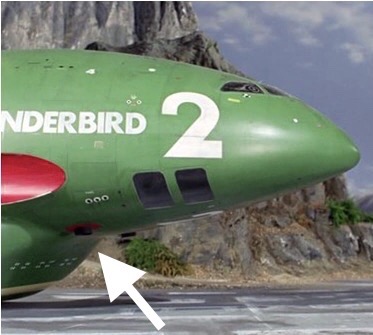
The apertures that I highlighted above with an arrow are never seen emitting an exhaust plume at all but seem likely to be another part of the vertical thrust or manoeuvring system — possibly the primary system.
To be clear, I do not think that one of the greatest children's television series of all time needs apologists, but this Facebook argument might be of passing interest to fans of the show.
"One of Gerry Anderson's biggest mistakes was that Thunderbird 2 when docking [sic] did not need vertical thrust until it ceased forward motion."I think you need to lay this nit pick at the door of the special effects team rather than him personally.
Regarding vertical thrust, it is often shown (including in the 1960s movies, which are the most recent canonical source with highest production values) that both Thunderbird aircraft can hover without using their rocket engines. They make an audible jet whine when doing so. It makes as much sense to complain about the lack of rockets as it would to complain that Thunderbird 2 doesn't fly in a nose-up attitude when escorting Alan's Tiger Moth. It seems safe to assume that the Thunderbirds don't have the same constraints as conventional propellor aircraft.
Also, given that International Rescue are extremely secretive and it is established in the second movie (Thunderbird 6, 1968) that Brains invented actual anti-gravity technology, I wouldn't worry too much about the floating.
"But if Thunderbird 2 can hover by anti-gravity why have downward jets fire just when forward motion ceased?"This could be a feint to conceal the actual technology in use, it could be done to generate a smoke screen, it could be a routine or automated action, e.g. to check the launch system is operative before landing, or (by far the simplest explanation) simply a transition of the vertical thrusters to a higher-thrust mode of operation.
Maybe some aspect of the technology normally used to maintain altitude at low air speeds is unsuitable for use in ground effect.

The apertures that I highlighted above with an arrow are
never seen emitting an exhaust plume at all but seem likely
to be another part of the vertical thrust or manoeuvring
system — possibly the primary system.
If you think about it, it would be very dangerous and/or embarrassing if the launch rockets were to malfunction. Testing them could easily be a mandatory part of the pre-landing checks, along with checking that harnesses and hatches are secure, and that the fuel level is sufficient.